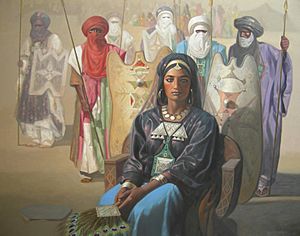Tin Hinan facts for kids
Quick facts for kids Tin Hinan |
|
|---|---|
| Tamenokalt | |

An oil painting entitled, The Queen Tin Hinan, by Hocine Ziani.
|
|
| Reign | 4th-century |
| Burial | Tin Hinan tomb |
Tin Hinan was a powerful Tuareg queen who lived a long time ago, in the 4th century. Her amazing tomb is found in the middle of the Sahara desert. It is located in a place called Abalessa in the Hoggar region of Algeria.
Contents
Who Was Tin Hinan?
Stories and Legends
Tin Hinan is often called the "Queen of the Hoggar." The Tuareg people also call her Tamenokalt, which means "queen." Her name can be translated as "woman of the tents." But many people think it means "mother of us all," showing how important she was.
Local stories say that Tin Hinan was a "fugitive princess." This means she was a princess who had to leave her home. She lived around the 300s AD. The legends say she and her group of followers almost died in the desert. But they found grain in anthills, which saved them!
Other stories say Tin Hinan was a Muslim woman from the Berber tribe. She came from an oasis called Tafilalt in the Atlas Mountains of Morocco. She traveled with her maidservant, Takamat. In these stories, Tin Hinan had a daughter (or granddaughter) named Kella. Takamat had two daughters. These children are believed to be the ancestors of the Tuareg people who live in the Ahaggar area today. Another version says Tin Hinan had three daughters. Their names were like desert animals, and they became the ancestors of different tribes.
Her Ancient Tomb
For a long time, the story of Tin Hinan was just a legend. Many people thought she was not a real person. But in 1925, explorers found her tomb! This proved that she was a real historical figure.
Her tomb is near the oasis of Abalessa in Algeria. It is about 1,000 miles (1,550 kilometers) south of Algiers. The tomb sits on a rounded hill, about 125 feet (38 meters) high. The tomb itself is shaped like a pear. It is about 88 feet (27 meters) long and has 11 rooms inside.
Discovering the Queen's Treasures
Opening the Tomb
The tomb of Tin Hinan was first opened in 1925. This was done by Byron Khun de Prorok with help from the French army. Later, in 1933, archaeologists studied it more carefully.
Inside, they found the skeleton of a woman. She was probably buried in the 4th century AD. She was lying on her back on a wooden bed. Her head was facing east.
Amazing Finds
The queen was buried with many valuable items. She had heavy gold and silver jewelry. Some pieces were decorated with pearls. On her right arm, she wore 7 silver bracelets. On her left arm, she had 7 gold bracelets. Another silver bracelet and a gold ring were also found with her. There were also pieces of a beautiful necklace made of gold and pearls.
Other special objects were found too. These are called funerary objects. They included a small "Venus" statue and a glass cup (which was lost later during World War II). They also found iron arrowheads, an iron knife, and a piece of gold foil. This gold foil had the mark of a Roman coin from Constantine I. This coin was made between 308 and 324 CE.
These finds helped experts figure out when she lived. The wooden bed was carbon-dated to the 4th or 5th century. The pottery style and a Roman lamp also matched this time. The tomb walls have special writings called Tifinagh inscriptions. The way the tomb was built is common in the Sahara desert.
Scientists studied the skeleton. They found it belonged to a tall, middle-aged Berber woman. Today, her body is kept at the Bardo National Museum in Algiers.
See also

- In Spanish: Tin Hinan para niños

